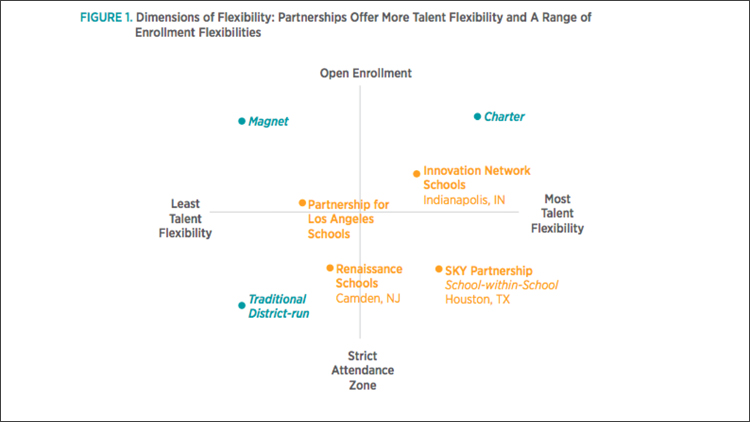Across the country, in Atlanta, Camden, Indianapolis and at least ten other cities, more schools are operating under a kind of partnership school model: a “third way” governance strategy that breaks through district-charter divides. Some education leaders, like Fordham Institute president Mike Petrilli, think this approach should be avoided at all costs. But others, myself included, see it as a potentially promising way to turn around struggling schools or increase the number of quality school options in a neighborhood.
Partnership schools might be thought of as the next stage in district-charter collaboration or a key component in implementing a portfolio management strategy. With a few mature exceptions, most of these arrangements are relatively new. The theory behind what their role is and how well it delivers is largely untested, and student outcomes have not been expressly studied. A new CRPE brief offers a lay of the land on this promising approach and outlines questions that policymakers and researchers should consider as more of these partnerships grow.
Partnership schools, like charter schools, enjoy more freedom than a traditional district-run school. But partnership schools are legally distinct from charter schools. In some cases, districts can open them through contracts. In other cases, specific state laws allow the district to open and run schools with a more local context than they could as a charter school authorizer. Most partnership schools are operated by a local charter network, or incubated alongside charter schools, but rather than seeking authorization, they enter into contracts with districts and become special district schools.
How are partnership schools different from district and charter schools? Broadly speaking, partnership schools have less flexibility than charter schools, but more autonomy than a typical district-run school. The image below is one way to think about two main areas of school flexibility: the ability to hire or replace teachers and the ability to recruit students from a wide geography. School leaders have opinions about both. Charter schools tend to have the most flexibility over both of those dimensions while district-run traditional schools tend to have the least flexibility. Magnet schools, which are district-run, typically are not tied to attendance zones but have the same teacher talent policies as other district schools. Various partnership models can score high in one dimension while being low in the other: Renaissance Schools in Camden have more talent flexibility than traditional district schools, but still mostly serve students in a set neighborhood, while Innovation Network schools in Indianapolis have some talent and enrollment flexibility.
Of course, there are many other attributes, policies, services, and other areas of autonomy that go into running a school. When partnership schools are created, the contractual agreement typically defines these autonomies, but gives more leeway to both the district and the partnership school to define the parameters than a charter agreement would: for example, more flexibility around enrollment.
Partnership arrangements require work to set up and maintain. Charter operators need the contracts to strike the right balance, making sure the schools keep enough autonomy to maintain a distinctive approach to instruction and guarding against their freedoms being gradually eroded by district policy. And districts need to apply the right incentives and “teeth” to make sure that the operators who seek partnerships are “committed to the community,” as one charter leader involved in a partnership school said, “and not just to the perks of enrollment zones.”
On the plus side, partnership schools can help solve charters’ growing need for school facilities and provide a firm answer to the charge that some students will be left behind. They can provide districts with new options for families that need them while empowering principals, teachers, and families in ways that the traditional district structure cannot. And partnership schools may provide a financial benefit to districts worried about enrollment loss: The students remain enrolled in the district, with at least some revenues remaining available to district leaders.
Lastly, partnership schools could lead to innovation in instructional models and the emergence of more diverse school options than under a strictly charter or district model. While more study is needed, students, families, and neighborhoods could experience meaningful and long-lasting benefits.
This commentary was first published on Fordham Institute’s Gadfly blog.





